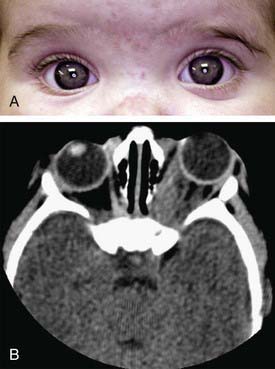Chapter 625 Orbital Abnormalities
Orbital Inflammation
Thyroid-related ophthalmopathy is thought to be secondary to an immune mechanism, leading to inflammation and deposition of mucopolysaccharides and collagen in the extraocular muscles and orbital fat. Involvement of the extraocular muscles can lead to a restrictive strabismus. Lid retraction and exophthalmos can cause corneal exposure and infection or perforation. Involvement of the posterior orbit can compress the optic nerve. Treatment of thyroid-related ophthalmopathy may include the use of systemic corticosteroids, radiation of the orbit, eyelid surgery, strabismus surgery, or orbital decompression to eliminate symptoms and protect vision. The degree of orbital involvement is often independent of the status of the systemic disease (Chapter 562).
Tumors of the Orbit
Various tumors occur in and about the orbit in childhood. Among benign tumors, the most common are vascular lesions (principally hemangiomas) (Fig. 625-1) and dermoids. Among malignant neoplasms, rhabdomyosarcoma, lymphosarcoma, and metastatic neuroblastoma are the most common. Optic nerve gliomas are most often seen in patients with neurofibromatosis and can manifest with poor vision or proptosis. Retinoblastoma can extend into the orbit if it is discovered late or if it goes untreated. Teratomas are rare tumors that typically grow rapidly after birth and exhibit explosive proptosis.
Gorospe L, Royo A, Berrocal T, et al. Imaging of orbital disorders in pediatric patients. Eur Radiol. 2003;13:2012-2026.
Krassas GE. Childhood Graves’ disease and its ophthalmic complications: some sensitive issues. J Endocrinol Invest. 2008;31:582.
Ohtsuka K, Hashimoto M, Suzuki Y. A review of 244 orbital tumors in Japanese patients during a 21-year period: origins and locations. Jpn J Ophthalmol. 2005;49:49-55.
Russo V, Scott IU, Querques G, et al. Orbital and ocular manifestations of acute childhood leukemia: clinical and statistical analysis of 180 patients. Eur J Ophthalmol. 2008;18:619-623.
Shields JA, Shields CL, Scartozzi R. Survey of 1264 patients with orbital tumors and simulating lesions: the 2002 Montgomery Lecture, part 1. Ophthalmology. 2004;111:997-1008.
Yuen SJA, Rubin PAD. Idiopathic orbital inflammation. Arch Ophthalmol. 2003;121:491-499.







